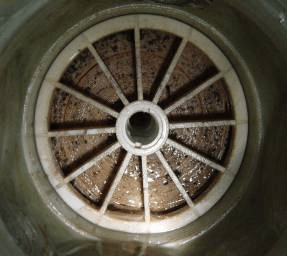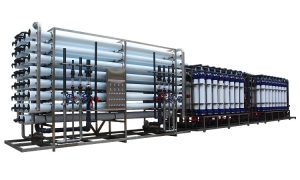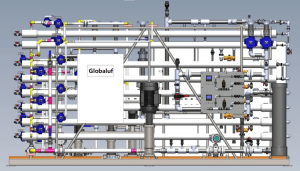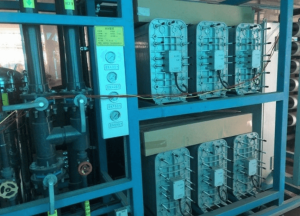How to Desalinate Sea Water: The Ultimate Guide to SWRO Technology
Introduction
With freshwater scarcity becoming a global challenge, seawater desalination has emerged as a critical solution to provide clean, drinkable water. Among the various desalination technologies, Seawater Reverse Osmosis (SWRO) stands out as the most efficient and widely adopted method.
In this article, we’ll explore the main seawater desalination technologies, with a focus on SWRO (Seawater Reverse Osmosis Desalination), its benefits, and how Globaluf’s advanced SWRO systems deliver high-performance desalination solutions.
Main Seawater Desalination Technologies
1. Multi-Stage Flash Distillation (MSF)
MSF is one of the oldest desalination methods, where seawater is heated to produce steam, which is then condensed into freshwater.
- Pros: Reliable, suitable for large-scale plants.
- Cons: High energy consumption, expensive to operate.

2. Multi-Effect Distillation (MED)
Similar to MSF but more energy-efficient, MED uses multiple evaporation stages to maximize freshwater recovery.
- Pros: Lower energy demand than MSF.
- Cons: Still energy-intensive compared to membrane-based methods.

3. Electrodialysis (ED)
Uses electric currents to remove salt ions from seawater.
- Pros: Effective for brackish water.
- Cons: Less efficient for high-salinity seawater.

4. Seawater Reverse Osmosis (SWRO) – The Leading Technology
SWRO (Seawater Reverse Osmosis Desalination) is the most advanced and cost-effective method today. It uses high-pressure pumps to force seawater through semi-permeable membranes, removing up to 99.7% of salts and impurities.

Why SWRO is the Best Choice for Seawater Desalination?
✔ Energy Efficiency
Compared to thermal desalination (MSF/MED), SWRO consumes up to 50% less energy, making it more sustainable.
✔ High Recovery Rates
Modern SWRO systems achieve 40-50% water recovery, meaning nearly half of the seawater input becomes freshwater.
✔ Compact & Scalable
Unlike large thermal plants, SWRO systems can be modular, making them ideal for small islands, ships, and coastal cities.
✔ Lower Operational Costs
With advancements in membrane technology and energy recovery devices (ERDs), SWRO has become the most economical desalination solution.
How Does SWRO Work? (Step-by-Step Process)
Seawater Intake & Pretreatment
-
- Seawater is filtered to remove sand, algae, and large particles.
- Chemical dosing (antiscalants) prevents membrane fouling.
High-Pressure Pumping
-
- Seawater is pressurized (800-1,000 psi) to overcome osmotic pressure.
Reverse Osmosis Membrane Filtration
-
- SWRO membranes block salt ions, bacteria, and viruses, allowing only pure water to pass.
Post-Treatment & Mineralization
-
- The desalinated water is remineralized for taste and stability.
Brine Disposal
-
- The concentrated brine is safely discharged or further treated.
Globaluf’s Advanced SWRO Desalination Systems
At Globaluf, we specialize in high-efficiency SWRO plants designed for:
✅ Municipal water supply
✅ Industrial applications (power plants, oil & gas, mining)
✅ Island & shipboard desalination
Why Choose Globaluf SWRO Systems?
✔ Customizable designs (containerized, skid-mounted, large-scale plants)
✔ Energy-saving ERD technology (reduces power consumption by 30%)
✔ High-quality membranes (Dupont, Toray, Hydranautics compatible)
✔ 24/7 technical support & maintenance
Explore our SWRO solutions: Globaluf Seawater Desalination Systems
Conclusion
Seawater Reverse Osmosis (SWRO) is the most efficient and sustainable desalination technology today. With lower energy costs, high recovery rates, and scalability, it’s the preferred choice for governments and industries worldwide.
Globaluf delivers cutting-edge SWRO systems tailored to your needs—whether for municipal, industrial, or remote applications.
Contact us today for a free consultation!
Request a Quote
Fill out the form below to discuss your water treatment needs. Our experts will get back to you within 24 hours.
You may also be interested in:

The Hidden Threat: Your Expert Guide to Preventing RO Membrane Biofouling

The Silent Killer of RO Systems: A Complete Guide to Preventing Membrane Oxidation

Understanding RO Membrane Scaling: Causes, Effects, and Prevention Strategies

Beyond the Basics: Advanced Reverse Osmosis System Design by Globaluf

Navigating Water Quality Fluctuations: Globaluf's Expertise in Safeguarding Membrane System Performance

Comprehensive Guide to EDI System Maintenance: Effective Cleaning Techniques and Prevention Strategies

Key Parameters at RO Feed Water – The First Line of Defense in RO Desalination

How to Build a Complete Bottled Water Production Line: A Comprehensive Guide

What is the Best Water Filter for Home?

